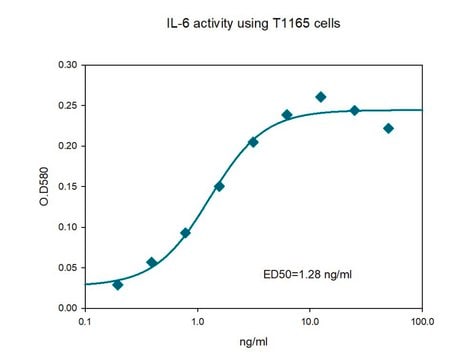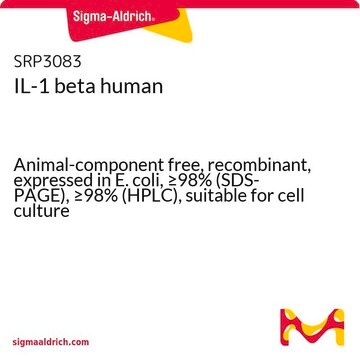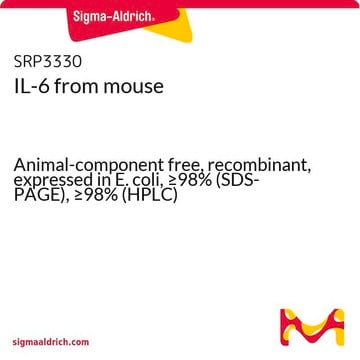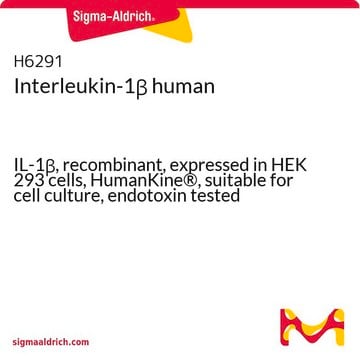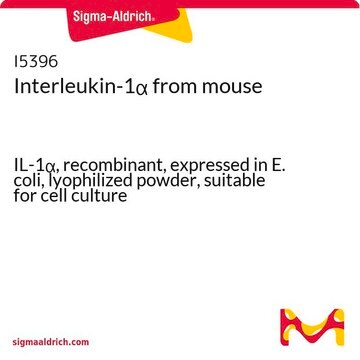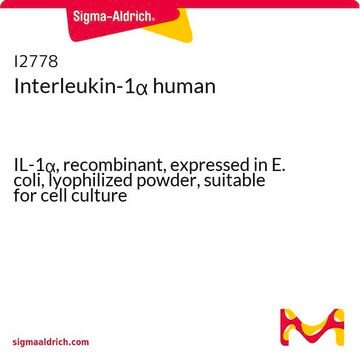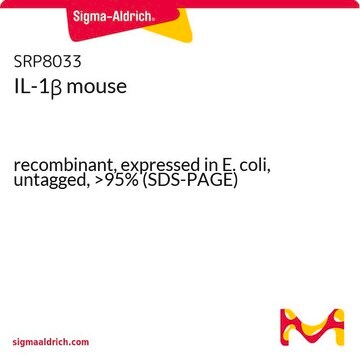I9646
Interleukin-6 from mouse
IL-6, recombinant, expressed in E. coli, lyophilized powder, suitable for cell culture, carrier free
Synonym(s):
mIL-6, IL-6
Sign Into View Organizational & Contract Pricing
All Photos(2)
About This Item
Recommended Products
biological source
mouse
Quality Level
recombinant
expressed in E. coli
Assay
≥97% (SDS-PAGE)
form
lyophilized powder
potency
0.02-0.2 ng/mL EC50
quality
endotoxin tested
mol wt
~21.7 kDa
packaging
pkg of 5 and 25 μg
technique(s)
cell culture | mammalian: suitable
impurities
≤1.0EU/mg
color
white
UniProt accession no.
storage temp.
−20°C
Gene Information
mouse ... Il6(16193)
Biochem/physiol Actions
Interleukin-6 (IL-6) is a multifunctional protein originally discovered in the media of cells stimulated with double stranded RNA. IL-6 appears to be directly involved in the responses that occur after infection and injury and may prove to be as important as IL-1 and TNF-α in regulating the acute phase response. IL-6 is reported to be produced by fibroblasts, activated T cells, activated monocytes or macrophages, and endothelial cells. It acts upon a variety of cells, including fibroblasts, myeloid progenitor cells, T cells, B cells and hepatocytes. IL-6 induces multiple effects, as indicated by its numerous synonyms: plasmacytoma growth factor (PCT-GF), interferon-β-2 (IFN-β2), monocyte derived human B cell growth factor, B cell stimulating factor (BSF-2), hepatocyte stimulating factor (HSF), Interleukin Hybridoma/Plasmacytoma-1 (IL-HP1). In addition, IL-6 appears to interact with IL-2 in the proliferation of T lymphocytes. IL-6 also potentiates the proliferative effect of IL-3 on multipotential hematopoietic progenitors.
Physical form
Lyophilized from a sterile filtered solution with no additives.
Analysis Note
The biological activity of recombinant mouse IL-6 was measured in a cell proliferation assay using T1165.85.2.1 cells.
Storage Class Code
11 - Combustible Solids
WGK
WGK 3
Flash Point(F)
Not applicable
Flash Point(C)
Not applicable
Personal Protective Equipment
dust mask type N95 (US), Eyeshields, Gloves
Certificates of Analysis (COA)
Search for Certificates of Analysis (COA) by entering the products Lot/Batch Number. Lot and Batch Numbers can be found on a product’s label following the words ‘Lot’ or ‘Batch’.
Already Own This Product?
Find documentation for the products that you have recently purchased in the Document Library.
Customers Also Viewed
Marrah E Lachowicz-Scroggins et al.
American journal of respiratory cell and molecular biology, 43(6), 652-661 (2010-01-19)
Infection of airway epithelium by rhinovirus is the most common cause of asthma exacerbations. Even in mild asthma, airway epithelium exhibits mucous metaplasia, which increases with increasing severity of the disease. We previously showed that squamous cultures of human airway
Jee Eun Choi et al.
STAR protocols, 3(2), 101389-101389 (2022-05-24)
Metabolic reprogramming is associated with myeloid-derived suppressor cell (MDSC) immunosuppressive function. Here, we outline the process for acquiring MDSCs from human and murine sources for subsequent analysis of fatty acid oxidation, oxidative phosphorylation, and glycolysis using the Seahorse XFe 96
R P Nordan et al.
Journal of immunology (Baltimore, Md. : 1950), 139(3), 813-817 (1987-08-01)
Plasmacytoma growth factor (PCT-GF), a putative macrophage-derived lymphokine essential for the in vitro viability and proliferation of early generation plasmacytomas, was purified from conditioned medium of the murine macrophage cell line P388D1. The purification of PCT-GF was accomplished by a
Jiawen Yong et al.
International journal of molecular sciences, 23(15) (2022-08-13)
Ciliary neurotrophic factor (CNTF) was identified as a survival factor in various types of peripheral and central neurons, glia and non-neural cells. At present, there is no available data on the expression and localization of CNTF-receptors in cementoblasts as well
JiSheng Hu et al.
Molecules and cells, 43(8), 749-762 (2020-09-02)
The migration, dedifferentiation, and proliferation of vascular smooth muscle cells (VSMCs) are responsible for intimal hyperplasia, but the mechanism of this process has not been elucidated. WD repeat domain 1 (WDR1) promotes actin-depolymerizing factor (ADF)/cofilin-mediated depolymerization of actin filaments (F-actin).
Our team of scientists has experience in all areas of research including Life Science, Material Science, Chemical Synthesis, Chromatography, Analytical and many others.
Contact Technical Service

